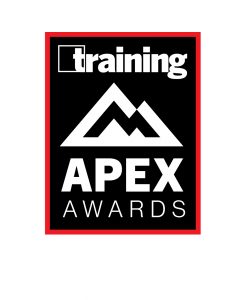
California utility Pacific Gas & Electric (PG&E) developed a predictive model to identify employees at highest risk of ergonomic injuries and implemented a proactive, multi-layered intervention approach that includes supervisor training and one-on-one coaching. The program aims to decrease overall risk scores of high-risk employees by at least 15 percent, driving annual reduction of musculoskeletal disorders (MSDs) and sprains/strains.
Program Details
In 2021, PG&E launched its Office Ergonomics—Predictive Model and paired it with a training strategy consisting of ergonomic training of direct supervisors; one-on-one supervisor/employee sessions; and targeted, proactive coaching for high-risk employees. The predictive model combines data from PG&E’s office ergonomics system with other sources to better predict employees who may be at higher risk for developing an office ergonomics injury. It is a machine learning model that utilizes a complex algorithm developed by PG&E’s safety data analytics team.
The objective of the predictive model and the establishment of risk-measured probabilities advances PG&E’s four goals:
- A healthier workforce
- A proactive intervention prior to injury occurrence
- An injury reduction
- Increased employee comfort
There are three training components related to the predictive model:
- SAFE-0409: Office Ergonomics Training: All employees who work in an office environment complete this training and a self-assessment of their primary workstation annually. Upon completion of the training and self-assessment, employees receive a risk score (high, moderate, low) and system-generated personalized guidance on actions they can take to reduce their risk and improve their comfort and efficiency. The majority of employees are able to reduce their workstation setup risk through application of the training and the personalized guidance provided upon completion of their self-assessment.
- 1:1 Coaching: After running the model, employees who are identified as high risk receive 1-1 coaching and training from an ergonomics specialist to educate them on best practices and techniques to reduce their risk. Details include:
- Each predictive model intervention takes place over six weeks. During this period, an ergonomics specialist arranges a 60-minute, 1-1 coaching/training session with each identified employee. The number and duration of subsequent follow-up sessions are determined by the ergonomics specialist based on the findings and recommendations from the initial session.
- The primary statistics discussed during the 1-1 coaching sessions are Peak and Average Strain from Keyboard Use and Peak and Average Strain from Mouse Use, as well as break trends.
- Coaching consists of RSIGuard (break timer software) education, keyboard and mouse strain mitigation strategies (hotkeys, shortcuts, dictation, etc.), as well as general tips for hand/wrist strain reduction, stress reduction, wellness and sleep, and stretching.
- Follow-up sessions allow the ergonomics specialist to gauge what strategies are successful and adjust or provide additional strategies as needed based on the employee’s feedback.
- SAFE-0700WBT: Office Ergonomics for Supervisors: Supervisors of identified at-risk employees complete this 45-minute Web-based training to better understand ergonomics risk and how to support their employees with ergonomics needs and concerns. Following completion of the Web-based training, supervisors complete a check-in discussion with their identified employees to learn how they can support them. Supervisors with at-risk employees are required to complete SAFE-0700WBT every three years as long as they oversee one or more high-risk employee.
Since the program’s launch in 2021, 700-plus leaders across all lines of business have participated in the supervisor training.
Results
The first full-model run of the predictive model occurred in mid-2021. It was run again in the first half of 2022, with plans to run the model twice a year going forward. Since the program’s launch in 2021, 1,647 high-risk employees (across all lines of business) identified by the predictive model have received 1:1 coaching.
Short-term study of model results after each intervention has shown a reduction in office ergonomics risk after 1-1 coaching and supervisor involvement, with the vast majority demonstrating significant reduction in at least one factor.
Results from third quarter 2021 include:
- 82 percent of employees improved in at least one risk factor.
- 86 percent dropped out of high risk for Average Keyboard Strain.
- 79 percent dropped out of high risk for Average Mouse Strain.
Results from first quarter 2022 include:
- 86 percent of employees showed improvement in at least one risk factor.
- 85 percent of targeted employees in low/average risk for Average Keyboard Strain factor post-round
- 61 percent of targeted employees in low/average risk for Average Mouse Strain factor post-round




